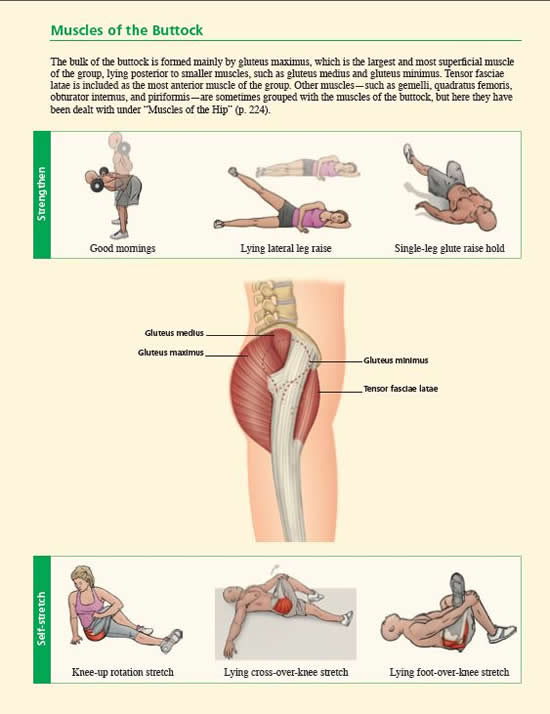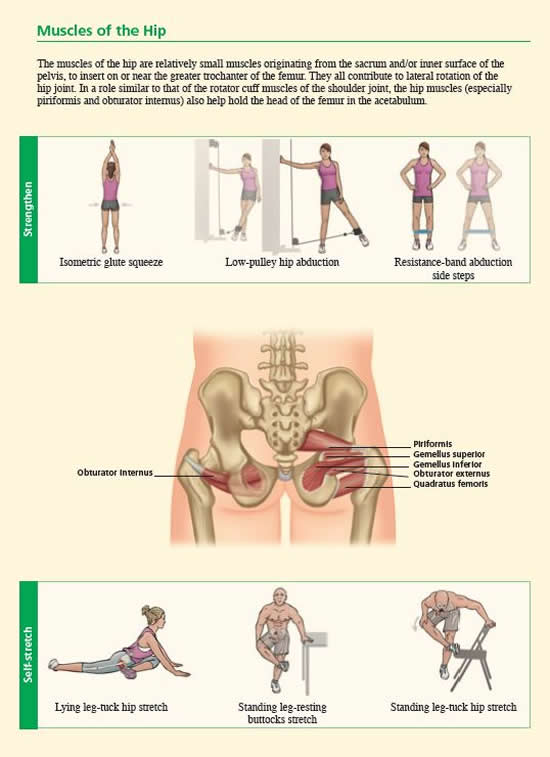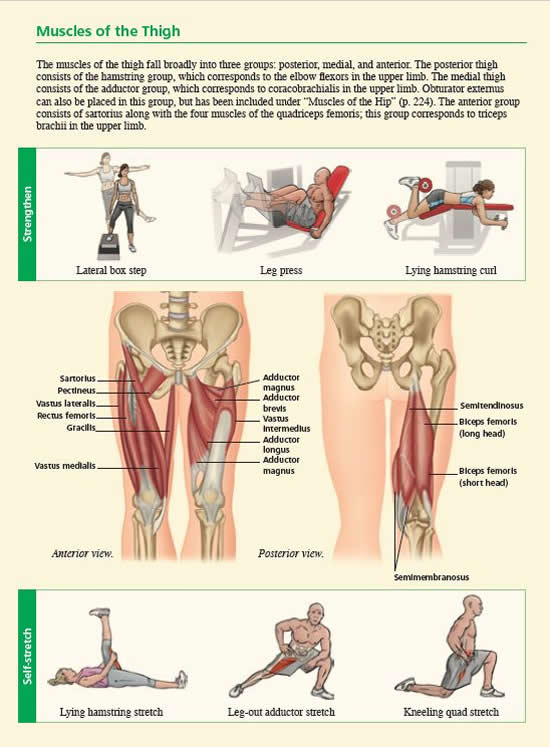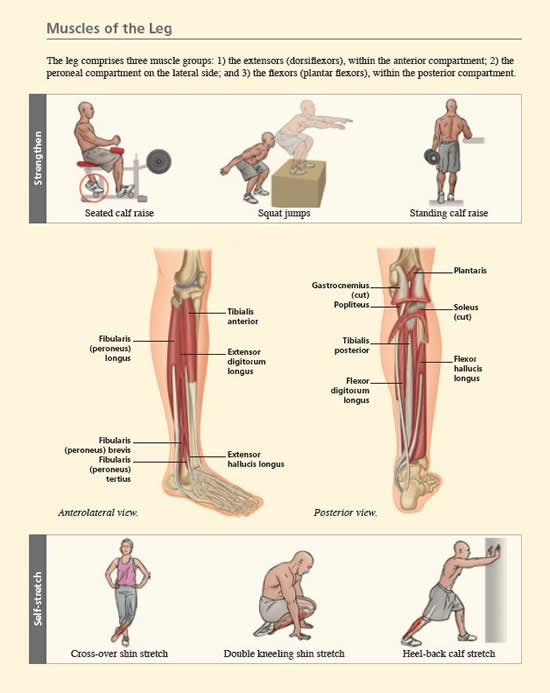Positive Health Online
Your Country

Muscles of the Hip, Thigh, Leg and Foot - Extract Concise Book of Muscles
by Chris Jarmey and John Sharkey(more info)
listed in anatomy and physiology, originally published in issue 228 - February 2016
This is an extract from The Concise Book of Muscles 3rd Edition by Chris Jarmey / John Sharkey. Lotus Publishing. 2015.
Muscles of the Hip and Thigh
The hips and buttocks are comprised of a number of both large (e.g. gluteus maximus) and small (e.g. piriformis) muscles; these muscles are primarily responsible for hip stabilization and lower limb movement. The muscles around the hip and buttocks, along with the structure of the hip joint, allow a large range of motion of the lower limb, including flexion, extension, adduction, abduction, and rotation.
The bulk of the buttock is formed mainly by the gluteus maximus, which is the largest and most superficial muscle of the group, lying posterior to smaller muscles, such as gluteus medius and gluteus minimus. Gluteus maximus contributes to powerful hip extension for explosive activities such as sprinting.
The abductors (tensor fasciae latae, gluteus medius, and gluteus minimus) are located on the lateral side (outside) of the thigh and posterior pelvis. They originate at the top outer edge of the pelvis and extend down the outside of the thigh, attaching to the lateral side of the tibia. The primary action of the abductors is to abduct (draw away from the midline) and medially (internally) rotate the hip joint.

Tensor fasciae latae lies anterior to gluteus maximus. It is a superficial muscle of the upper thigh that keeps the pelvis level and stabilizes the knee when standing on one leg; it also assists in flexion of the hip joint. Many painful conditions of the knee can arise because of a short spastic tensor fasciae latae.
Gluteus medius is mostly deep to, and therefore obscured by, gluteus maximus, but appears on the pelvic surface between gluteus maximus and tensor fasciae latae. During walking, gluteus medius, along with gluteus minimus, prevents the pelvis from dropping toward the non-weight-bearing leg. When gluteus medius is tight, pelvic imbalances may result, leading to pain in the hips, low back, and knees. Gluteus minimus lies deep to gluteus medius, whose fibers obscure it; as its name implies, it is the smallest of the gluteal muscles. As with gluteus medius, when gluteus minimus is tight, pelvic imbalances may occur.
Located under the gluteal muscles, the six deep rotators (piriformis, gemellus superior and inferior, obturator internus and externus, and quadratus femoris) are the smallest muscles of the hip and are primarily responsible for lateral (outward) rotation.

Piriformis is a small, tubular muscle that originates on the anterior surface of the sacrum, inserts at the superior border of the greater trochanter of the femur (posterior trochanteric line), and leaves the pelvis by passing through the greater sciatic foramen. The muscle assists in laterally rotating the femur in the hip joint and in abducting the thigh when the hip is flexed; it also helps hold the head of the femur in the acetabulum.
Gemellus superior and gemellus inferior (the gemelli) are small, thin muscles that cross the hip joint from the area of the ischium to the greater trochanter of the femur. Their path is almost horizontal across the joint.
Lying between the two gemelli, the obturator internus has a broad origin on a part of the pelvis called the obturator foramen, along with portions of the lower iliac bone. Besides being an outward rotator, it is a strong stabilizer of the hip.
The obturator externus is an ideal rotator of the hip because of its position. It passes from the lower end of the obturator foramen, then behind the neck of the femur, to attach to the greater trochanter of the femur on the medial side. Its line of pull allows the head of the femur to roll laterally inside the socket of the pelvis, creating outward, or external, rotation.
The most inferior (lowest) deep rotator is the quadratus femoris; this is a short muscle running almost horizontally from the upper portion of the ischial tuberosity to the femur (at the level of the gluteal crease).

The hamstrings are a large group of three separate muscles located in the posterior (rear) thigh. Originating from the bottom of the ischial tuberosity and extending to below the knee, they work together to extend the hip and flex the knee; these muscles correspond to the flexors of the elbow in the upper limb. During running, the hamstrings decelerate the leg at the end of its forward swing and prevent the trunk from flexing at the hip joint.
The three muscles of the hamstrings are, from medial to lateral, semimembranosus, semitendinosus, and biceps femoris. Biceps femoris is the largest hamstring muscle, and has two heads, the long and the short; the long head crosses the hip joint to work it. Semitendinosus and semimembranosus are completely synergistic, meaning that they both do the exact same actions; however, they can also oppose each other, causing internal or external rotation of the tibia–fibula complex.
The adductors are a large group of muscles located on the medial (inner) side of the thigh. They originate at the bottom of the hipbone and extend down the inside of the thigh, attaching to the medial/posterior side of the femur.
Pectineus is the most superior adductor; its primary action is adduction, or bringing the thigh toward the midline of the body. Gracilis attaches from the pubis symphysis to the tibia, below the knee. The muscle shapes the superficial inner thigh, but is relatively weak, working the knee joint as well as the hip.
The three muscles specifically named adductors are adductor magnus, adductor brevis, and adductor longus. North American anatomists also include an adductor minimis. The muscles travel down the inside of the thigh, starting at the anterior pubis area of the pelvis and attaching to the medial length of the femur. The magnus is the largest of the three, and spreads out to cover the fullest area of the inner thigh.
The primary action of the adductors is to adduct (draw toward the midline) the femur in the hip joint, but most of them also rotate the femur: pectineus and gracilis inwardly rotate, and adductor brevis and magnus outwardly rotate. All adductors function as stabilizers of the lower limb when weight is placed upon it, as well as stabilizers of the pelvis.
The quadriceps (or quadriceps femoris) is a large group of muscles, the heftiest of the lower limb, located in the anterior (front) of the thigh. These muscles originate from above the hip joint and extend to below the knee. The primary action of the quadriceps is to extend the knee joint; however, in conjunction with a number of other muscles in the front of the hip, the quadriceps is also associated with hip flexion.
Rectus femoris is part of the quadriceps femoris, which also includes the vasti group (vastus lateralis, vastus medialis, and vastus intermedius). This spindle-shaped bipennate muscle has two heads of origin: the reflected head is in the line of pull of the muscle in four-footed animals, whereas the straight head seems to have developed in humans as a result of the upright posture.
The quadriceps straightens the knee when rising from sitting, during walking, and while climbing. The vasti muscles cross only the knee, and thus are limited to knee extension or resistance to knee flexion; they pay out to control the movement of sitting down. Vastus medialis is larger and bulkier (also referred to as the teardrop muscle) than vastus lateralis. Vastus intermedius is the deepest part of the quadriceps femoris, and has a membranous tendon on its anterior surface to allow a gliding movement between itself and the rectus femoris, which overlies it. The quadriceps tendon attaches to, and covers, the patella; it becomes the patellar tendon below the knee, attaching to the tibia.
Included here is sartorius, not part of the quadriceps femoris group, but the most superficial muscle of the anterior/medial thigh; it is also the longest strap muscle in the body. The medial border of the upper third of this muscle forms the lateral boundary of the femoral triangle (adductor longus forms the medial boundary and the inguinal ligament forms the superior boundary). The action of sartorius is to put the lower limbs in the cross-legged seated position of the tailor (hence its name from the Latin).

Muscles of the Leg and Foot
The muscles of the shin originate at the top of the tibia, just below the knee joint, and extend down the front of the shin and over the ankle joint. The primary action of the shin muscles is to dorsiflex, extend, or invert the ankle joint.
Tibialis anterior originates from the lateral condyle of the tibia, and inserts into the medial and plantar surfaces of the medial cuneiform bone. Tibialis anterior is responsible for dorsiflexing and inverting the foot and is used frequently during running to “toe up” with each step. Pain in the front of the shin occurs when the muscle and tendon become inflamed and irritated through overuse or improper form.
The extensor hallucis longus and extensor digitorum longus are the main extensor muscles of the toes; their tendons run over the front of the ankle and over the foot, and attach to the toes. These muscles dorsiflex the foot and work in opposition to the flexor muscles. When the calf muscles are tight, or the muscles are worked beyond their exertion level, inflammation of the tendons may occur.
Fibularis (peroneus) tertius, fibularis (peroneus) longus, and fibularis (peroneus) brevis form the lateral compartment of the lower leg. All these muscles pronate, but the last two also act as plantar flexors and evertors at the ankle joint, as well as preventers of inversion and protectors against ankle sprain. The course of the tendon of the insertion of fibularis (peroneus) longus helps maintain the transverse and lateral longitudinal arches of the foot.
The calf muscles are located on the posterior (rear) of the leg and lower portion of the femur. They attach from the heel bone (calcaneus) to their origin on the medial and lateral condyles of the femur, just above the knee joint. The primary actions of the calf muscles are to plantar flex the ankle joint and flex the knee.
The superficial gastrocnemius has two heads and crosses two joints: the knee and the ankle. It is part of the composite muscle known as triceps surae, which also includes soleus and plantaris. Triceps surae forms the prominent contour of the calf. Gastrocnemius is quite a thin muscle when compared with the thick soleus. As well as plantar flexing the ankle, gastrocnemius assists in flexion of the knee joint, and is a main propelling force in walking and running. Explosive sprinting, for example, may rupture the Achilles tendon at its junction with the muscle belly of gastrocnemius, hence the need to keep the muscle well stretched.
Plantaris, a small muscle, is a weak plantar flexor of the ankle, but plays an important neurological role in assessing and adjusting the tension in the Achilles tendon. The long slender tendon of plantaris (the longest tendon in the body) is equivalent to the tendon of palmaris longus in the arm. Interestingly, plantaris is thought to be what remains of a larger plantar flexor of the foot.
Part of triceps surae, soleus is so called because its shape resembles a fish. This is a good example of how anatomical nomenclature does little to inform a reader regarding the possible function of a named structure; in this case, something has been named simply because it looks like a fish. Soleus is deep to gastrocnemius, but its medial and lateral fibers bulge from the sides of the leg and extend further distally than gastrocnemius. As well as helping to plantar flex the ankle, soleus assists in flexing the knee. The constant wearing of high-heeled shoes tends to cause this muscle to shorten, which can affect postural integrity.
Popliteus is a thin, flat, triangular muscle forming the floor of the distal portion of the popliteal fossa located on the posterior surface of the knee. It is continuous above with the femur by means of a strong tendinous attachment to the lateral femoral condyle. Interestingly, this muscle is also continuous below with the joint capsule, specifically the lateral meniscus, and continues to the head of the fibula via the arcuate popliteal ligament and the medial two-thirds of the superior tibia on the soleal line.
Flexor digitorum longus, flexor hallucis longus, and tibialis posterior form the deep posterior compartment of the lower leg. Tibialis posterior is the deepest muscle and helps maintain the arches of the foot. Flexor hallucis longus helps maintain the medial longitudinal arch of the foot, while flexor digitorum longus flexes the phalanges of the second to fifth toes and plantar flexes and inverts the ankle.
The feet and ankles are comprised of a multitude of small muscles that control the foot. The muscles around this region, along with the structure of the joints, allow a large range of motion of the feet and ankles, including flexion, extension, adduction, abduction, and rotation.
There are four layers of muscles in the sole of the foot. The first layer is the most inferior (i.e. the most superficial and closest to the ground in standing), comprising abductor hallucis, flexor digitorum brevis, and abductor digiti minimi. Abductor digiti minimi forms the lateral margin of the sole of the foot. The second layer contains the lumbricales and quadratus plantae, along with the tendons of flexor hallucis longus and flexor digitorum longus. The third layer contains flexor hallucis brevis, adductor hallucis, and flexor digiti minimi brevis. The fourth layer is the deepest (and most superior) layer of muscles of the sole of the foot; it consists of the four muscles of the dorsal interossei and the three muscles of the plantar interossei, as well as the tendons of tibialis posterior and peroneus longus. On the dorsum of the foot lies extensor digitorum brevis.
One structure worth noting is a tough fibrous tissue connecting the heel to the toes - the plantar fascia, also called the plantar aponeurosis. Repetitive ankle movement, especially when restricted by tight calves, can irritate this tissue at the insertion on the heel. Specific dynamic stretches may help to alleviate this problem.
Further Information
Available from Amazon
www.amazon.co.uk/Concise-Book-Muscles-Chris-Jarmey/dp/1905367627
www.amazon.com/Concise-Book-Muscles-Chris-Jarmey/dp/1905367627
Comments:
-
No Article Comments available